So you’re a musician, podcaster, or content creator who needs to record high-quality audio on the go.
A compact, lightweight audio interface might be just what you need.
With the advancements in technology, interfaces are becoming more portable.
But with so many options on the market, how do you know which one is the best for you?
In this article, we’ll explore some of the top portable audio interfaces.
We’ll look at what sets them apart and help you make an informed purchase.
Let’s dive in!
Overview
PreSonus Relevator io44 (Best Overall)
The PreSonus Revelator io44 is a small audio interface that comes with many features, including XMAX-L mic preamp, onboard effects processing, and audio loopback functionality, making it ideal for solo musicians, podcasters, and streamers.
Its compact and portable design also makes it easy to take on the go.
However, it only has one mic input and can’t record a microphone and instrument simultaneously.
Audient Evo 4 (Runner-Up)
The Audient Evo 4 is a compact audio interface with a unique design and a single knob that controls almost everything, including input gain, output volume, monitor mix blend, and panning.
It features advanced capabilities such as Smart Gain and audio loopback, making it a great value for its $130 price point.
While the build and design quality isn’t top-notch, and the one-knob design takes some getting used to, the Evo 4 is a great option for mobile recording with solid sound quality and useful features.
Apogee Jam Plus (Ultra-Compact)
The Apogee Jam+ is a portable guitar interface that features 24-bit/96 kHz audio resolution converters, overdrive mode, Bias FX jam software, and zero latency monitoring and recording.
Its sleek design, rugged metal exterior, and easy-to-use knobs and buttons make it a durable and convenient option.
iRig Pre HD (Ultra-Compact)
The iRig Pre HD is a simple and compact mic interface with an XLR mic input, gain control, phantom power, and direct monitoring on/off switch.
This unit works well with the Shure SM7B and has a lower noise floor than many interfaces in its price range.
However, it’s limited in terms of I/O compared to other options, and the Revelator io44 has more features for the same price.
PreSonus AudioBox Go (Budget Option)
The PreSonus AudioBox Go is a compact and lightweight audio interface that packs in a combo mic/line input, an instrument input, and two balanced outputs, making it perfect for a solo or two-person recording session.
It features a monitor mix knob for latency reduction and is an affordable and easy-to-use option for beginners or those looking for a portable recording solution.
However, it is important to note that it is not the most durable and may require a protective travel case. Its inputs are located on the back, which can feel awkward but makes it more compact for travel purposes.
Focusrite Scarlett 2i2 (Portable x Home Studio Hybrid)
The Focusrite Scarlett 2i2 is a popular and compact audio interface that offers great recording quality, flexible connectivity options, and a user-friendly interface.
Its standout feature is Air Mode, a mic preamp emulation that subtly boosts high frequencies in your audio, making your recordings sound more polished and professional.
Motu UltraLite Mk5 (High I/O Count)
The Motu UltraLite Mk5 is a high-quality, portable audio interface boasting 22 inputs and 18 outputs, onboard DSP processing, and a durable metal chassis.
It produces exceptional sound quality, but lacks clipping indicators and is pricey at $650.
The 7 Best Portable Audio Interfaces
PreSonus Revelator io44
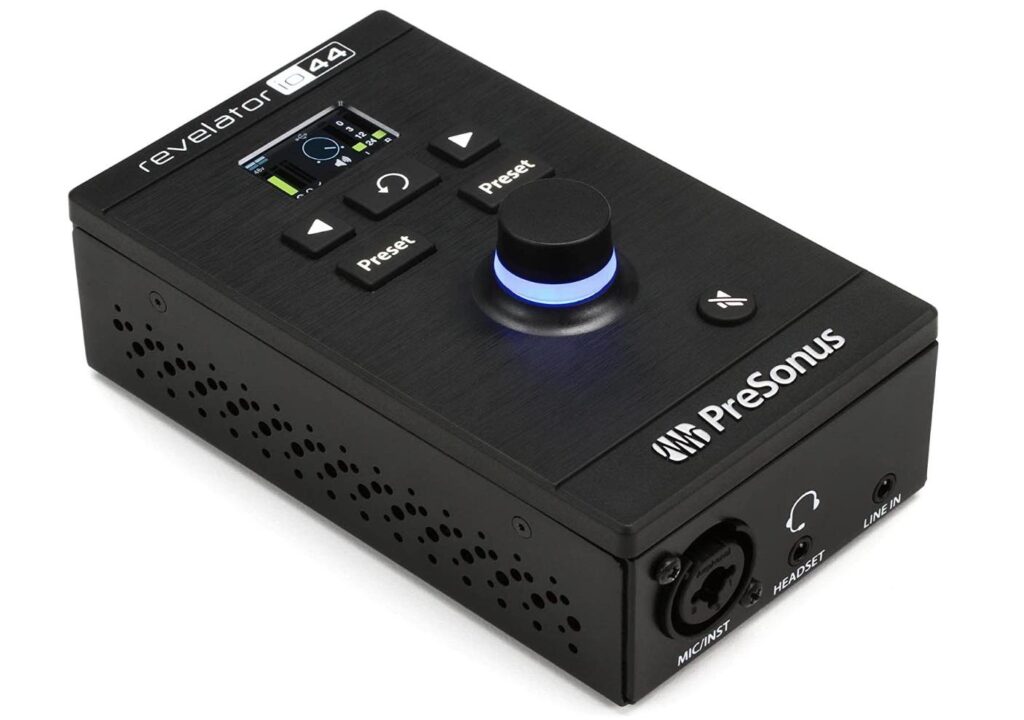
The PreSonus Revelator io44 is a pocket-sized audio interface with a combo mic/instrument input and two balanced outputs.
It’s surprising how many features come with such a little device.
It gives you just about everything you need to record professional audio as a solo musician, podcaster, or streamer.
You’ll get an XMAX-L mic preamp, onboard effects processing, a level meter screen, and audio loopback functionality.
Its mic preamp delivers crystal-clear audio with plenty of headroom and low noise.
However, you may have to max out your gain with low-output dynamic mics, such as the Rode Pod mic and the Shure SM7B.
Obviously, maxing out your gain isn’t ideal as it makes noise more noticeable. But you can reduce noise by recording a louder signal, using noise reduction software, or using a cloud lifter.
Overall, for an interface in this price range, its preamp doesn’t disappoint.
You’ll also be able to adjust how your mic or instruments sounds in real-time using DSP effects.
These effects include a range of presets for EQ, compression, reverb, and more, which you can access and adjust using the included control software.
This software is intuitive and easy to use, allowing you to make quick adjustments. And with the ability to save and recall custom presets, you can streamline your workflow.
The best part about these onboard effects is that they won’t put additional strain on your computer’s CPU.
This unit is also great for recording video interviews, tutorials, and live reactions due to its audio loopback capabilities.
Audio loopback allows you to capture your voice and audio playing through your computer or device, such as music or sound effects.
Because of this feature, you can record high-quality videos with synchronized audio from multiple sources.
This aspect of the io44 makes it ideal for creating engaging content for social media, YouTube, or other online platforms.
Additionally, the unit’s compact and portable design makes it easy to take on the go, allowing you to record high-quality videos and podcasts from any location.
On the flip side, the io44 only has one mic input.
It’s also unable to record a microphone and instrument at the same time since it has a combo mic/instrument input.
Therefore, if you need to collaborate the Revelator io24 is a better option. But considering the io44’s $130 price tag it’s one of the most inexpensive options you’ll find with onboard effects.
Audient Evo 4
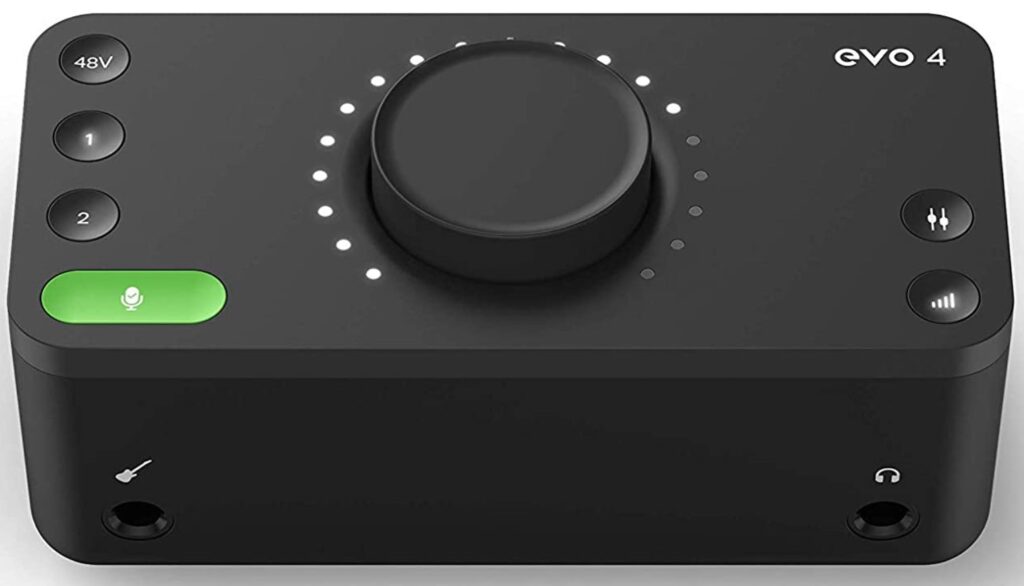
The Audient Evo 4’s unique design allows it to be more compact than most interfaces.
This unit doesn’t have multiple knobs like you’ll see on most interfaces – just one knob that controls almost everything.
You can use this knob to adjust your input gain, main output, and headphone volume, monitor mix blend, and panning.
You can also control these features through the included Evo Control software.
What makes this unit stand out is its advanced features and impressive recording quality for an interface priced at around $130.
It features Smart Gain which enables its preamps to set their own gain – a capability that allows you to set accurate gain levels with no effort.
You can also link your inputs to set their gain at the same time when recording stereo pairs.
In addition to its controls, the Evo 4 lets you take advantage of audio loopback which is useful for podcasting and streaming.
As mentioned before, audio loopback allows you to record your computer audio into your software alongside your mic or instrument audio.
So if you need to record a video call or react to a video online, the Evo 4 has you covered.
While this unit delivers impressive sound quality at the $130 price point with condenser mics and instruments, there are better dynamic mix options.
Also, its build and design quality leaves a lot to be desired.
Its plastic housing feels and bit flimsy.
Plus, its one-knob design can take some getting used to if you’re accustomed to multiple-knob interfaces.
But would we recommend EVO 4 for mobile recording?
Yes. Absolutely.
With the proper care, this unit can last a long time.
And its compact design makes it easy to slip into your bag and have where ever you go.
Ultimately, its features and solid recording quality make it a great value for its price.
Apogee Jam Plus
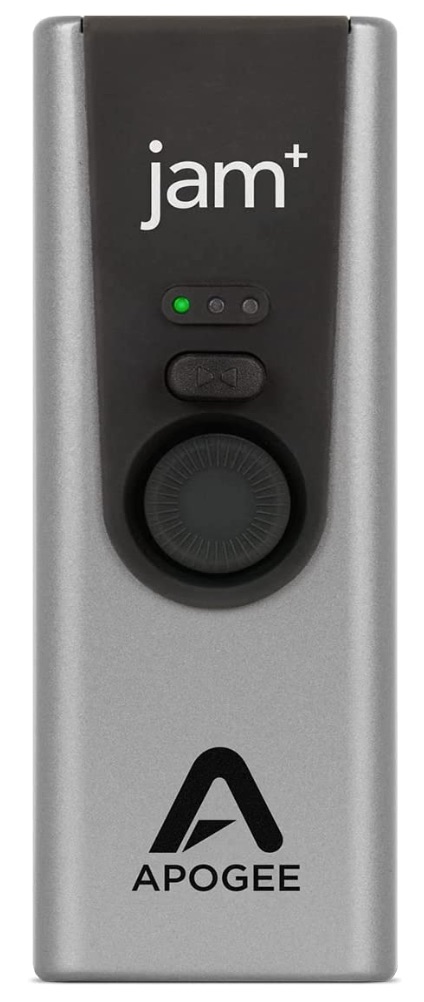
Looking for a portable interface to connect your guitar?
One of the most portable options is the Apogee Jam+.
It features 24-bit/96 kHz audio resolution converters, overdrive mode to add more grit to your audio, Bias FX jam software, and zero latency monitoring and recording.
First, let’s talk about the design.
It’s sleek, compact, and has a rugged metal exterior that makes you feel like you’re holding a piece of equipment that’s built to last.
Also, its knobs and buttons are all well-made and easy to use, with a smooth tactile response.
There’s an output blend control in the center for zero-latency recording. Underneath you’ll find a gain control knob that you can push to select Overdrive or Clean mode.
These modes give you the flexibility to adjust your sound to your liking, whether you’re going for a clean, crisp tone or a gritty, distorted sound.
Overall, the Apogee Jam+ is a well-designed and thoughtfully crafted piece of equipment that’s easy to use.
iRig Pre HD
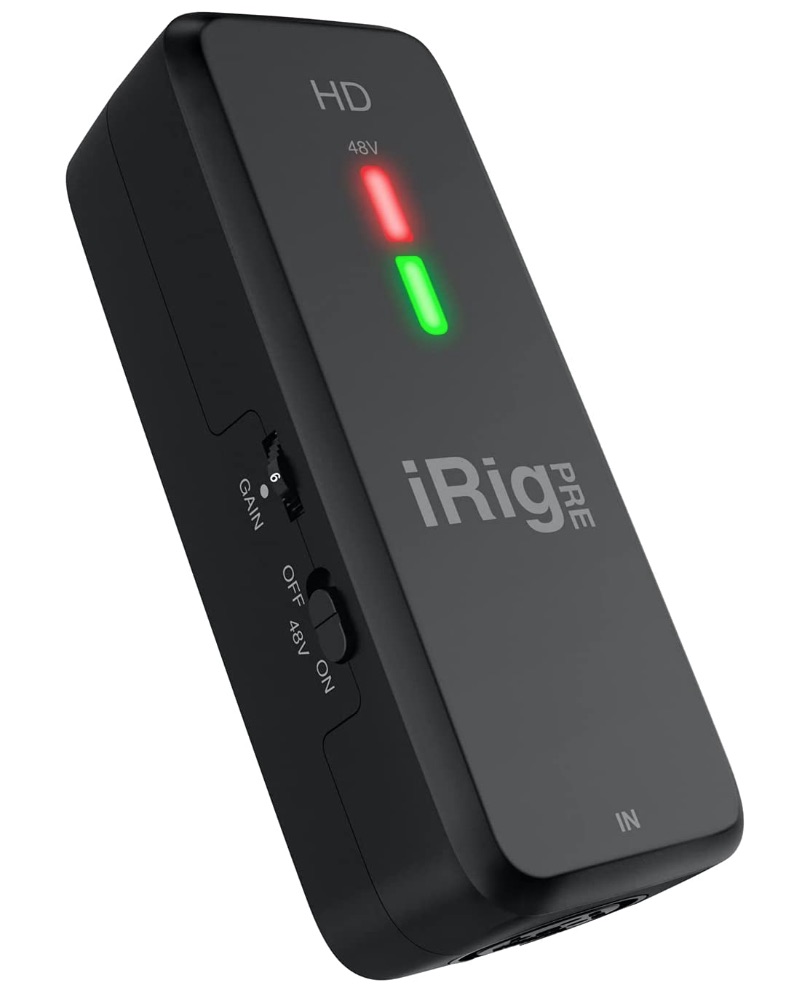
The iRig Pre HD is the mic interface version of the Apogee Jam+.
It has an XLR mic input with a high-quality mic pre, a gain control, phantom power, and a direct monitoring on/off switch – everything you need to record audio from a microphone.
It’s simple and compact but doesn’t disappoint with its recording quality.
We recommend the iRig Pre if you’re a musician, vlogger, or streamer who’s constantly on the go.
It allows you to capture studio-quality audio without the burden of transporting large equipment.
I was surprised by how well this unit works with the Shure SM7B which is known to require a strong mic preamp.
The preamp adds some noise, but it won’t ruin your recording if you’re recording a loud enough signal.
With condenser mics, the iRig Pre produces clear audio. No complaints in this category.
Best of all, this unit works with all iOS devices and android devices making it ideal for mobile recording.
On the downside, this interface has a limited number of inputs and outputs.
If you’re looking for a portable interface that you can also use in your home studio, there are better options in this price range.
PreSonus AudioBox Go
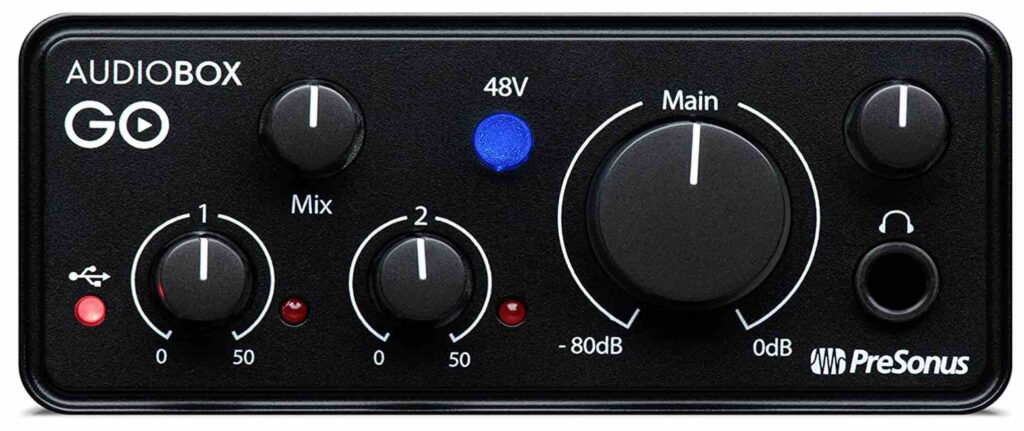
The PreSonus AudioBox Go doesn’t waste any space.
It packs in a combo mic/line input, an instrument input, and two balanced outputs in a 3.4 by 4.4-inch, .5 lb. design.
In other words, this unit will take up very little space on your desk or in your travel case
It features 24-bit, 96kHz audio resolution converters and provides just what you need for a solo or two-person recording session.
The AudioBox Go doesn’t have any advanced features but we like that it features a monitor mix knob for latency reduction.
This knob lets you blend your direct input signal with the playback audio from your computer.
It’s especially useful when you want to minimize latency while recording through effects like reverb and EQ in your DAW.
The AudioBox Go doesn’t have all the bells and whistles of a more advanced audio interface. But its affordability and ease of use make it an excellent choice for beginners or anyone looking for a portable recording solution.
One thing to keep in mind before purchasing this unit is that it isn’t the most durable.
It’s housed in a plastic structure that can be damaged during travel if you don’t take the proper precautions.
Consider traveling with this unit in a small protective case to preserve its structure over time.
Also, this interface’s inputs on located on the back which can feel a bit awkward when you’re using it on a home studio desk.
However, having its inputs on the back allows this unit to be more compact which makes it ideal for travel.
Focusrite Scarlett 2i2
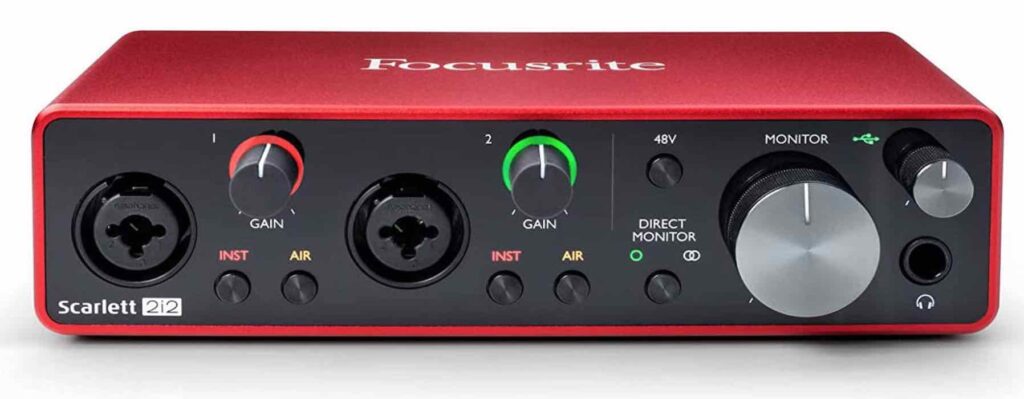
The Focusrite Scarlett 2i2 is the most popular audio interface for good reasons.
This compact and robust device offers great sound quality, flexible connectivity options, and a user-friendly interface.
These qualities make the 2i2 ideal for anyone looking for a quality home studio interface that is also road ready.
Its simple user interface makes navigating this unit very straightforward.
You’ll get used to using it in no time.
Plus, its two high-performance microphone preamps and professional-grade converters, make it one of the best performers under $200.
Ultimately, the feature that makes this interface stand out is Air Mode. It’s a mic preamp emulation inspired by Focusrite’s legendary ISA preamps.
With the Air Mode engaged, your audio will sound brighter and more open due to a subtle boost to its high frequencies.
This boost can add a polish to your audio that’ll make it stand out more in your mix.
This feature is especially useful for recording and mixing in a home studio environment where the acoustics may not be optimal.
With Air Mode, you can add a professional touch to your recordings and make them sound like they were made in a top-of-the-line studio.
Motu UltraLite Mk5
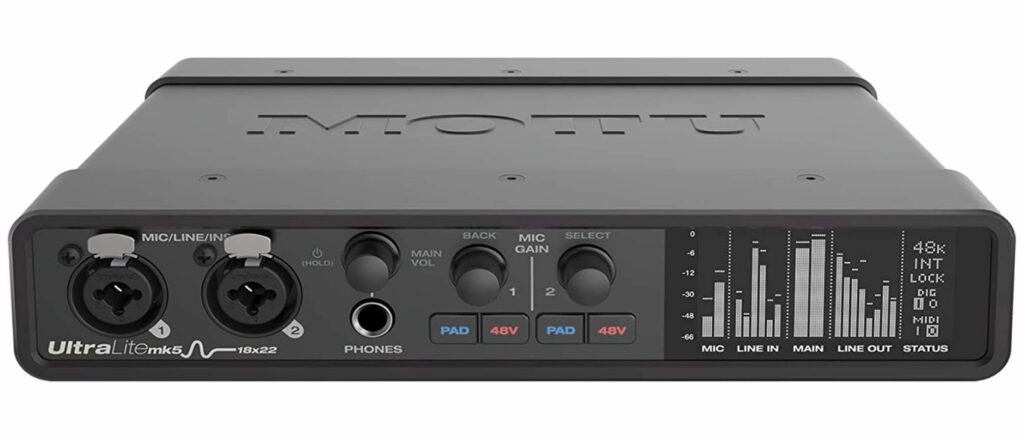
Motu’s UltraLite Mk5 is one of the best portable options.
It delivers high-quality sound, 22 inputs and 18 outputs, and advanced features in a compact package.
This unit is a great lightweight option if you need to record a band, drum sets, or live performances and want to stay nimble.
UltraLite Mk5’s standout feature is its impressive array of inputs and outputs.
With 22 inputs and 18 outputs, this unit can handle the most complex recording setups.
It has eight analog inputs, including two mic/line/instrument inputs, six-line inputs, and two digital inputs.
The ten analog outputs include two main outs and eight-line outs.
Plus, a SPDIF, ADAT, headphone output, and MIDI I/O.
The audio quality of the UltraLite Mk5 is excellent, with high-resolution recording up to 192 kHz and 24-bit depth.
The preamps are clean and transparent, and the overall sound is detailed and accurate.
It also includes onboard DSP processing, including EQ, compression, and reverb, allowing for real-time processing and monitoring.
The build quality of the UltraLite Mk5 is also exceptional.
It has a durable metal chassis and a compact design that makes it easy to transport.
The front panel features an easy-to-read LCD display and a range of controls, including input and output gain, phantom power, and more.
On the downside, the UltraLite Mk5 doesn’t have any clipping indicators.
Its level meters are useful, but they won’t indicate when your input signals are too hot making it harder to avoid recording distorted audio.
This model is also a bit pricey at $650 – not ideal if you’re on a budget.
Overall, the Motu UltraLite Mk5 is an excellent audio interface that delivers exceptional sound quality and a range of features in a portable, compact package.
If you need to record a band, drum set, or live performance on the go, this unit is an excellent choice that will not disappoint.
What to Look For in a Portable Interface
An audio interface that’s great for travel will have all the inputs, outputs, and features you need in a unit that’s lightweight and compact.
Here are some factors to consider when searching for a road-ready audio interface.
Size and Portability
A portable audio interface should be easy to pack in a bag or case and use on the go.
Look for an interface that’s small, lightweight, and easy to transport but has all the essential components you need.
Input and Output Channels
Consider how many channels you need.
Many ultra-compact interfaces only have one or two inputs.
If you’re recording a solo artist, a two-channel interface may be sufficient. But if you need more than a couple of inputs, you’ll have to sacrifice some portability.
However, some interfaces are easy to transport but still have a lot of I/O such as the Motu UltraLite Mk5.
Durability
Durability for a portable interface is everything.
It’s easier to preserve an interface that you have sitting on your desk.
Once you start taking it on the road, anything’s possible.
You’ll want an interface that can remain intact and function through bumps and drops.
Therefore, an interface with a metal exterior and sturdy buttons and knobs is your best bet.
Other Factors to Consider
Connectivity
Look for an interface that has the appropriate connections for your device and the type of recording you plan to do.
Common connections include USB, Thunderbolt, and Lightning.
Preamps
Good preamps are essential for recording quality audio.
Look for an interface with high-quality preamps that provide clean gain without introducing noise.
Sample Rate and Bit Depth
Higher sample rates and bit depths can result in better audio quality.
Look for an interface that can support the sample rate and bit depth you need for your project.
Price
Portable audio interfaces come in a wide range of prices.
Consider your budget and look for an interface that provides the features and quality you need at a price you can afford.
Takeaway: Best Portable Audio Interfaces
Portable audio interfaces have been a game changer in audio recording, providing a convenient and efficient solution for recording high-quality audio on the go.
With the advancements in technology, today’s portable audio interfaces are capable of delivering professional-grade audio recordings with unmatched portability and ease of use.
Additionally, the market for portable audio interfaces is constantly evolving with new models and features being introduced regularly.
Therefore, its important for users to carefully consider their specific needs and budget before making a purchase.








